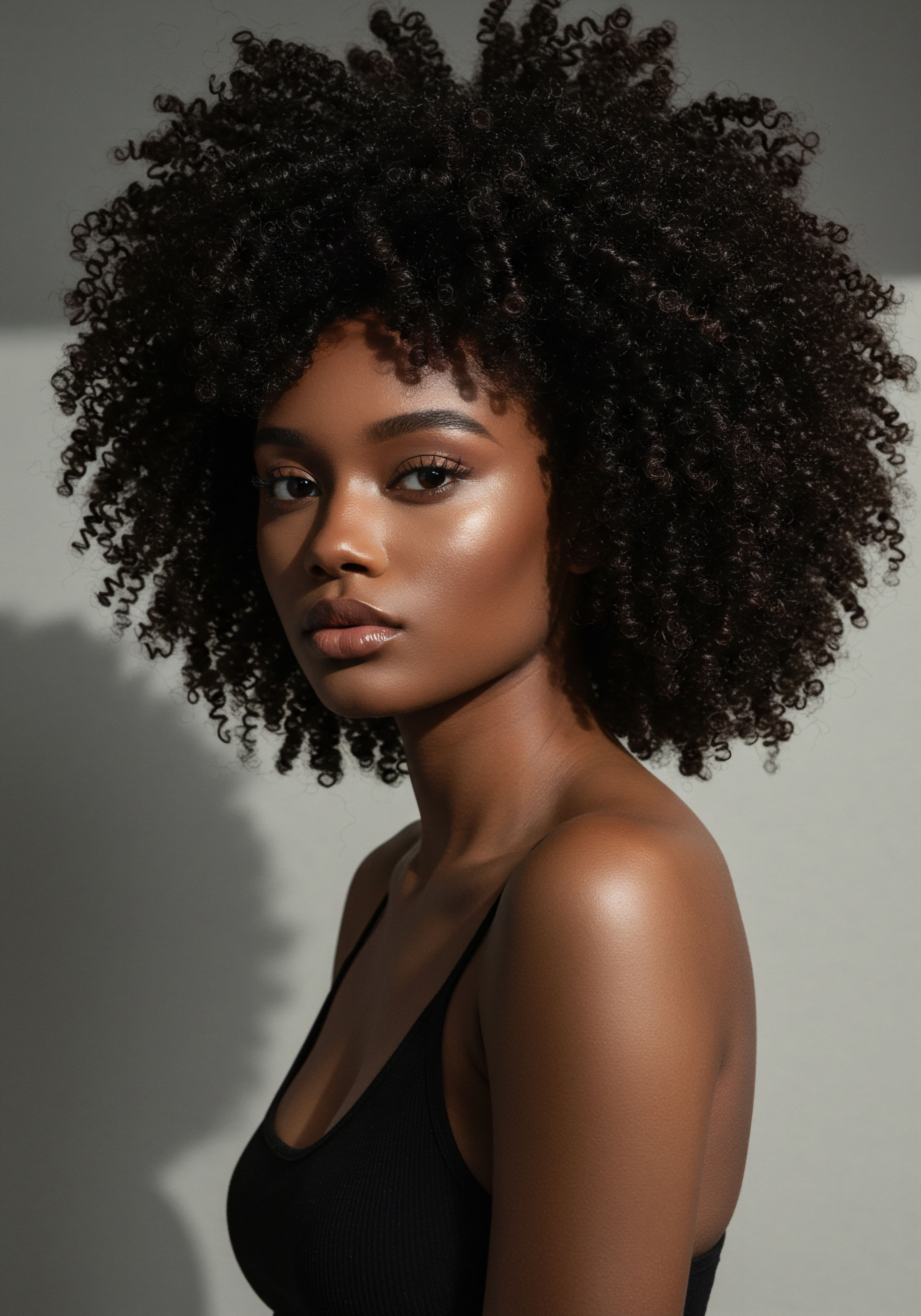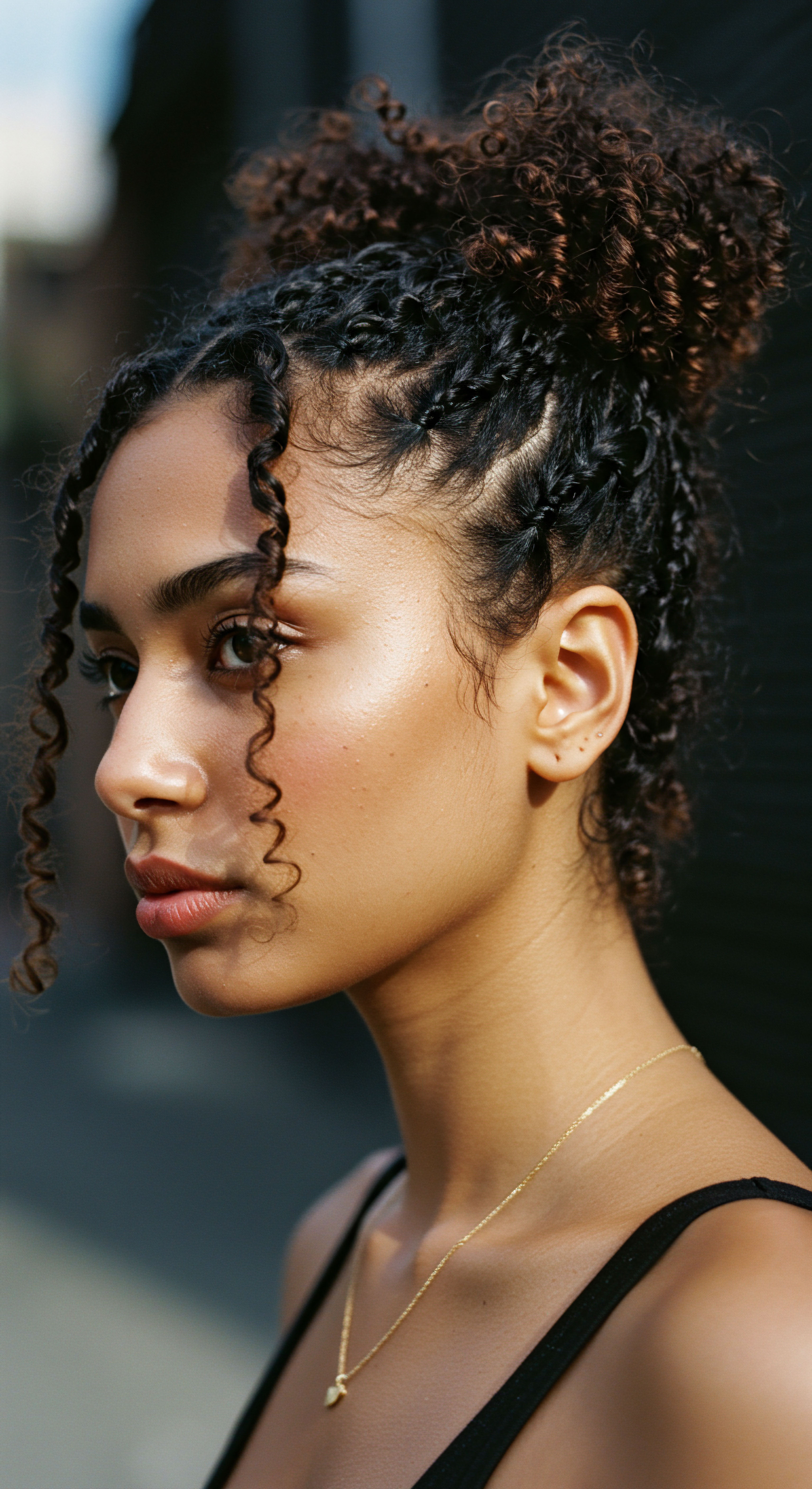
Roots
The quiet hum of the night, a world adrift in slumber, often feels distant from the vibrant life of our hair. Yet, beneath the surface, where each strand finds its genesis, a profound dialogue unfolds between the body’s restorative cycles and the delicate mechanisms of hair follicle regeneration. It is a conversation whispered not in words, but in the rhythmic ebb and flow of hormones, the subtle shifts in cellular activity, and the deep, unseen work of repair. We stand at the threshold of understanding this silent, vital connection, a bond that speaks to the very foundation of our well-being and the thriving potential of our textured strands.
Hair, particularly textured hair with its intricate spirals and robust structure, is more than just an adornment; it is a living extension of our physiological state. Its vitality is a testament to the complex biological processes that occur within the scalp. At the heart of this process lie the hair follicles, miniature organs residing within the skin, each capable of generating a single hair fiber. These follicles are not static entities; they cycle through distinct phases of growth, regression, and rest.
The nightly embrace of sleep holds a secret dialogue with the very core of our hair’s existence, influencing its regenerative dance.

The Hair Growth Cycle Unveiled
To truly appreciate how sleep touches our hair, one must first comprehend the rhythmic dance of the hair growth cycle. This cycle, a marvel of biological precision, is broadly categorized into three primary stages:
- Anagen ❉ This is the active growth phase, where hair cells multiply rapidly, forming the hair shaft. For textured hair, this phase can last for several years, determining the potential length of the hair. During anagen, the follicle is a hub of metabolic activity, demanding a steady supply of nutrients and energy.
- Catagen ❉ A brief, transitional phase, catagen marks the end of active growth. The hair follicle shrinks, and the hair detaches from its blood supply. This stage typically lasts only a few weeks.
- Telogen ❉ The resting phase. During telogen, the hair remains in the follicle but is no longer growing. A new anagen hair often begins to form beneath it, eventually pushing the old hair out. This phase can last for several months. Following telogen, the cycle restarts with a new anagen phase.
The harmonious progression through these phases is essential for maintaining hair density and vitality. Any disruption to this delicate balance can shift a greater proportion of follicles into the resting or shedding phases, leading to noticeable changes in hair appearance and health.

Cellular Architects of Hair
Within each hair follicle, a remarkable collection of specialized cells collaborates to construct the hair fiber. At the base lies the dermal papilla, a cluster of mesenchymal cells that plays a guiding role, communicating with the overlying matrix cells. These matrix cells are highly proliferative, differentiating to form the various layers of the hair shaft and its surrounding internal root sheath.
Another key player is the hair follicle stem cell population, residing in a region known as the bulge. These stem cells are dormant for extended periods but are activated at the start of each new anagen phase, providing the cellular material for follicle regeneration and hair growth. Their proper functioning is paramount for continuous hair production. The vitality of these stem cells, their ability to awaken and proliferate, is profoundly sensitive to systemic signals, including those influenced by our nocturnal repose.
The integrity of the hair follicle is also maintained by its rich vascular supply, which delivers oxygen and nutrients, and its intricate nerve innervation, which can transmit signals from the nervous system. The microenvironment surrounding the follicle, including the presence of various growth factors and cytokines, also dictates its behavior and regenerative capacity.

How Does Cellular Activity Synchronize with Sleep?
The body operates on a circadian rhythm, an internal biological clock that orchestrates physiological processes over approximately a 24-hour cycle. This rhythm influences everything from hormone secretion to cell division. Sleep is a central pillar of this rhythm, providing a dedicated period for cellular repair, energy restoration, and the synthesis of essential compounds.
During deep sleep, the body releases growth hormone, a potent anabolic agent that stimulates cell reproduction and regeneration. This hormone plays a role in the overall health of tissues, including the highly active cells of the hair follicle. Simultaneously, the body’s repair mechanisms are in full swing, addressing cellular damage accumulated throughout the day.
This nightly repair work is critical for maintaining the health and proliferative capacity of hair follicle cells, ensuring they are primed for their growth-generating tasks. A restful night offers the opportunity for these cellular architects to rebuild and prepare for the next cycle of creation.

Ritual
As the day’s demands recede and twilight softens the edges of our world, we often turn our thoughts to the quiet rituals that prepare us for rest. These moments, steeped in gentle care and intention, extend beyond the surface of our skin, reaching into the very core of our being. When we consider the profound connection between sleep and the regenerative pulse of our hair, our nighttime routines take on a new significance.
They become not just acts of personal comfort, but an acknowledgement of the body’s innate wisdom, a gentle alignment with the rhythms that allow our hair follicles to perform their silent, vital work. This section invites us to explore the practical wisdom embedded in our evening practices, recognizing how each mindful step can support the thriving potential of our textured hair.
The period of sleep is a time of profound physiological shifts, many of which directly impact the microenvironment of the hair follicle. It is during these hours that the body prioritizes repair, detoxification, and the synthesis of crucial biomolecules. For our hair, this means a window of opportunity for replenishment and growth.

The Body’s Nightly Repair Brigade
While we drift through dreams, our bodies are diligently working. The immune system strengthens, inflammation may decrease, and the body’s cellular repair mechanisms activate. These systemic processes indirectly but powerfully influence hair health.
A body well-rested and in a state of optimal repair is better equipped to supply the hair follicles with the resources they need to regenerate effectively. Conversely, disrupted sleep can trigger stress responses that divert resources away from non-essential functions, such as hair growth, prioritizing immediate survival.
Our evening practices, when steeped in mindful care, serve as a quiet accord with the body’s innate rhythms, supporting the hair follicle’s vital nightly work.
Consider the subtle signals the body sends. A persistent feeling of tiredness, a dullness in the skin, or a general lack of vibrancy often walk hand-in-hand with concerns about hair vitality. These outward signs are echoes of an internal state, suggesting that the foundational support systems for hair may be compromised.

Optimizing the Scalp Environment for Regeneration
The scalp is the soil from which our hair grows, and its health is intrinsically linked to the regenerative capacity of the follicles. Nighttime offers an ideal period to apply targeted care that can support the scalp’s microcirculation and provide direct nourishment.
One might consider a gentle scalp massage before bed. This simple act can stimulate blood flow to the follicles, delivering oxygen and nutrients more efficiently. When paired with a light, nourishing oil, such as jojoba or argan, it can also provide essential fatty acids and antioxidants, supporting the scalp’s barrier function and reducing potential inflammation.

How Does Nighttime Scalp Care Enhance Follicle Function?
Nighttime scalp care, when approached with thoughtful consistency, creates an optimal environment for hair follicle function. The absence of daily environmental aggressors, such as pollution and UV exposure, allows applied products to work more effectively. Furthermore, the body’s metabolic rate shifts during sleep, potentially enhancing the absorption of topical treatments.
| Benefit Enhanced Circulation |
| Impact on Hair Follicle Regeneration Delivers vital oxygen and nutrients, supporting cell proliferation in the dermal papilla and matrix. |
| Benefit Reduced Inflammation |
| Impact on Hair Follicle Regeneration Calms the scalp, creating a more favorable environment for stem cell activity and reducing factors that can trigger premature hair shedding. |
| Benefit Improved Product Absorption |
| Impact on Hair Follicle Regeneration Allows active ingredients from serums or oils to penetrate more deeply and interact with follicle cells without daytime interference. |
| Benefit Stress Reduction |
| Impact on Hair Follicle Regeneration Relaxing rituals before sleep can lower cortisol levels, which can otherwise negatively impact the hair cycle. |
| Benefit Consistent nighttime care provides a foundation for healthy hair follicle activity and overall hair vitality. |
The selection of products for nighttime care should be mindful. Opt for lightweight, non-comedogenic oils or serums designed to support scalp health. Ingredients like rosemary oil, known for its circulatory benefits, or peptides that signal cellular repair, can be valuable additions. The goal is to provide a gentle, supportive presence, allowing the follicles to conduct their restorative work undisturbed.

The Quiet Protection of Hair at Rest
Beyond direct scalp applications, the physical protection of textured hair during sleep is a time-honored practice with significant implications for its integrity and the health of its follicles. Textured hair, with its unique coil patterns, is prone to tangling, friction, and moisture loss.
Using silk or satin bonnets, scarves, or pillowcases creates a smooth, low-friction surface that minimizes mechanical stress on the hair shaft. This reduction in friction prevents breakage and preserves the hair’s natural moisture, which is essential for maintaining elasticity and preventing dryness that can extend down to the scalp.
When hair is protected, it means less pulling and tugging on the roots, which can otherwise irritate the follicles and potentially contribute to traction-induced shedding over time. A well-protected style also reduces the need for extensive manipulation in the morning, further minimizing stress on the hair and scalp. This quiet act of preservation contributes to a more serene environment for the follicles, allowing them to focus on their regenerative tasks without external disruption.

Relay
As we move beyond the immediate, tangible practices of hair care, a deeper understanding of sleep’s connection to hair vitality beckons. This realm of inquiry invites us to consider the intricate biological dialogues, the subtle hormonal shifts, and the profound impact of our internal clocks on the very life force of our hair follicles. It is here that the seemingly simple act of sleep reveals its complex layers, serving as a critical relay point for signals that govern growth, repair, and resilience. This exploration reaches into the nuanced interplay of scientific discovery, ancient wisdom, and the lived experiences that shape our understanding of hair health.
The relationship between sleep and hair follicle regeneration extends far beyond merely resting the body. It involves a sophisticated communication network within our physiology, where sleep acts as a conductor for a symphony of biological processes.

Hormonal Orchestration and Follicle Response
Our sleep cycles are inextricably linked to the rhythmic secretion of various hormones, many of which exert direct or indirect influence on hair follicle activity.
- Growth Hormone ❉ Secreted primarily during deep, non-REM sleep, growth hormone is a potent anabolic agent. It plays a role in cellular reproduction and tissue repair throughout the body, including the highly proliferative cells of the hair follicle. Adequate deep sleep ensures optimal levels of this hormone, providing a restorative signal for follicle growth.
- Melatonin ❉ This hormone, well-known for regulating sleep-wake cycles, is also a powerful antioxidant and has been shown to directly influence hair follicle biology. Melatonin levels naturally peak during the night in response to darkness. Research suggests that hair follicles themselves possess melatonin receptors and can synthesize melatonin locally.
- Cortisol ❉ Often called the “stress hormone,” cortisol levels naturally decrease during sleep. Chronic sleep deprivation can lead to elevated cortisol, which can shift hair follicles prematurely into the catagen (regressing) or telogen (resting) phases, leading to increased shedding.
The harmonious balance of these hormones, orchestrated by consistent sleep patterns, provides a stable internal environment conducive to robust hair growth. Disruptions, whether from irregular sleep schedules or chronic sleep deficiency, can throw this delicate balance into disarray, sending confusing or detrimental signals to the follicles.
Sleep acts as a sophisticated relay, transmitting vital hormonal signals that orchestrate the intricate dance of hair growth and repair within each follicle.

The Circadian Clock Within Each Follicle
A particularly fascinating discovery in dermatological science is the presence of an independent circadian clock within the hair follicle itself. This means that hair follicles possess their own internal timing mechanisms, allowing them to anticipate and respond to the body’s daily rhythms. This local clock influences the expression of genes involved in hair growth, differentiation, and pigment production.
When our systemic circadian rhythm (governed by the brain’s suprachiasmatic nucleus) is misaligned with these local follicular clocks, such as through irregular sleep patterns, shift work, or chronic jet lag, it can disrupt the hair follicle’s natural cycle. This desynchronization can lead to suboptimal growth, premature entry into resting phases, and a diminished capacity for repair.

Does Melatonin Directly Affect Hair Follicle Activity Beyond Sleep Regulation?
While widely recognized for its role in sleep, scientific inquiry reveals that melatonin extends its influence directly to the hair follicle, operating as more than just a sleep regulator. This particular aspect, while grounded in research, often surprises those accustomed to thinking of melatonin solely in the context of sleep.
For instance, a study published in the International Journal of Trichology highlighted the direct action of melatonin on hair follicles. Research indicates that Melatonin Acts as a Potent Antioxidant and can prolong the anagen (growth) phase of hair follicles, while simultaneously delaying the onset of the catagen (regressing) phase. This suggests a direct pro-growth and protective effect on the hair follicle, independent of its sleep-inducing properties. One study demonstrated that topical application of melatonin could increase the percentage of hairs in the anagen phase in individuals with diffuse alopecia, indicating a direct influence on the hair cycle.
This offers a compelling perspective ❉ the melatonin surge during natural, restorative sleep is not just aiding rest, but potentially delivering a direct, growth-promoting signal to our hair follicles, making quality sleep an internal treatment for our strands. The implication here is that the quality of our sleep, and the resulting nocturnal melatonin production, might be a direct, physiological contributor to hair vitality, a concept often overlooked in common hair care discussions.
This understanding challenges the simpler notion that sleep merely provides general rest for hair. Instead, it posits a specific biochemical mechanism through which adequate sleep, and its associated melatonin secretion, directly contributes to hair follicle health and growth. This makes the ritual of sleep a fundamental aspect of hair biology, not just a lifestyle choice.
| Sleep Disruptor Chronic Insomnia |
| Mechanism of Impact on Hair Follicle Elevated stress hormones (cortisol), leading to premature follicle regression and increased shedding. |
| Sleep Disruptor Irregular Sleep Schedules |
| Mechanism of Impact on Hair Follicle Desynchronization of systemic and local follicular circadian clocks, disrupting gene expression vital for growth. |
| Sleep Disruptor Light Exposure at Night |
| Mechanism of Impact on Hair Follicle Suppression of nocturnal melatonin secretion, potentially reducing its direct growth-promoting and antioxidant effects on follicles. |
| Sleep Disruptor Sleep Apnea |
| Mechanism of Impact on Hair Follicle Intermittent hypoxia and increased oxidative stress, which can damage follicle cells and impair regenerative capacity. |
| Sleep Disruptor Maintaining consistent, quality sleep patterns is a significant protective measure for hair follicle health. |

The Psychological and Social Tapestry
Beyond the biological, the psychological and social dimensions of sleep also weave into the story of hair health. Chronic sleep deficiency often accompanies increased stress, anxiety, and even depression. These psychological states can trigger a cascade of physiological responses, including heightened inflammation and altered immune function, which can negatively impact hair follicles.
Moreover, societal pressures and cultural expectations around productivity can often lead to the de-prioritization of sleep. In many contexts, sacrificing sleep is viewed as a badge of honor, a sign of dedication. This cultural narrative can inadvertently contribute to widespread sleep deficiency, impacting not only general health but also the subtle expressions of well-being, such as hair vitality. Recognizing sleep as a foundational pillar of health, rather than a luxury, is a shift that can empower individuals to reclaim their rest and, in doing so, support their hair from within.

Reflection
As we draw our thoughts together, it becomes clear that the seemingly simple act of closing our eyes each night opens a profound gateway to the vitality of our hair. The whispers of the body’s restorative cycles, the intricate dance of hormones, and the silent, diligent work of our hair follicles all converge within the gentle embrace of sleep. It is a reminder that true radiance springs from a place of deep, internal balance, a harmony nurtured not just by external applications, but by the fundamental rhythms of life itself. May we listen more closely to these quiet signals, honoring the profound connection between our inner repose and the flourishing beauty of our strands.

References
- Fischer, T. W. Slominski, A. Tobin, D. J. Paus, R. (2008). Melatonin and Hair Follicle ❉ A Comprehensive Review. Experimental Dermatology, 17(10), 895-901.
- Kadkhodaee, M. Afkhami, F. Zahmatkesh, M. et al. (2022). Melatonin ❉ A New Day for Hair Follicles. International Journal of Trichology, 14(1), 1-6.
- Al-Refai, A. Alkatan, H. Al-Hammadi, M. et al. (2020). The Effect of Sleep Deprivation on Hair Loss in Medical Students. Journal of Clinical and Aesthetic Dermatology, 13(10), 28-32.
- Slominski, A. T. Witalis, T. et al. (2018). Hair Follicle as a Local Circadian Clock ❉ The Role of Melatonin. Frontiers in Endocrinology, 9, 396.
- Ando, H. & Katagiri, T. (2018). Stress and Hair. In ❉ Hair Biology. Springer, Tokyo.